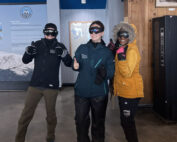NULL
2006-03-09 09:35:19.000 – Neil Lareau, Observer
Starting just before sunrise Tim and I began to observe a sheet of maritime moisture in the form of low clouds back in from the Southeast. Now, these clouds have pushed against the flanks of the mountains obscuring the Mount Washington Valley. Extending from each of the notches and low points of the range is a smooth tongue of stratocumulus that becomes ragged as it mixes with drier and evaporates. A few clouds have now made it as far north as Randolph. Along the Carter-Moriah range the clouds have found enough lift begin to flow over the top of the ridge. A few days prior the scenario had been reversed with low clouds trapped on the northern edges of the range.
The winds at the level of the summit are more southwesterly than those below us and are serving to pump warm air across the region. There is a thickening overcast with light precipitation evident 40 miles to the west.
An abbreviated sun pillar was evident in the moments before the sun itself crested the horizon. Ice crystals in high cirrus, and perhaps precipitating from a layer of altocumulus, allowed for this optical phenomenon to appear as what I would call a super sun, the opposite of a sub sun.
It looks now as though the first round of todays precipitation will fall as snow on the summit, but by tomorrow morning temperatures should be above freezing. Yuck.
Neil Lareau, Observer
Team Flags Return for Seek the Peak’s 25th Anniversary
Team Flags Return for Seek the Peak's 25th Anniversary By MWOBS Staff Mount Washington Observatory is looking forward to continuing a much-loved tradition for Seek the Peak’s 25th Anniversary: Team flags. In inviting teams
Meet Summer Interns Zakiya, Max and Maddie
Meet Summer Interns Zakiya, Max and Maddie By MWOBS Staff We are excited to welcome six teammates to the summit of Mount Washington this summer! During their internship, these students and graduates will play
Saying Goodbye to the Summit
Saying Goodbye to the Summit By Alexis George After an extraordinary last three years working as a Weather Observer and Meteorologist, I am excited to pursue a different career. As sad I as am




